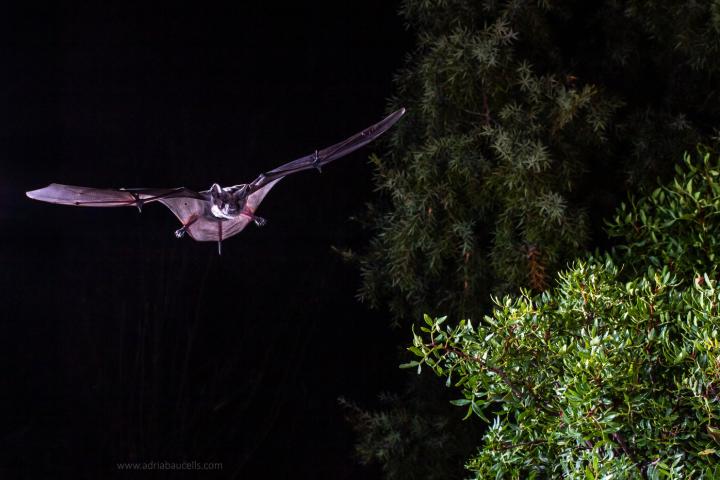Bats carried aloft to almost 2,000 metres by air currents

Credit: Adria Baucells
Bats are the only mammals that can actively fly. Some species travel over one hundred kilometres on their nocturnal excursions in search of food. Researchers at the Max Planck Institute of Animal Behavior in Radolfzell have now discovered that European free-tailed bats use uplifting winds for their ascents – a behaviour that was previously known only from birds. To do this, they tracked the bats using mini GPS loggers and then linked the flight data to weather data. The animals can thus gain altitude of well over 1,000 metres without expending much energy. The results also show that the bats reach flight speeds of up to 135 kilometres per hour.
Thanks to the development of small yet powerful GPS transmitters, researchers can accurately track the flight paths of bats. Together with colleagues from Portugal and the US, researchers from the Max Planck Institute of Animal Behavior in Radolfzell have fitted European free-tailed bats with such transmitters. The astonishing findings on the flight behaviour of these small mammals have been made possible only by the international cooperation of experts in animal behaviour, meteorology, biomechanics, and modelling.
Analysis of the GPS data has revealed that the bats often follow the natural course of the landscape and maintain the same height above the ground. However, every now and then, they literally shoot upwards only to plummet down again – a behaviour that researchers call a roller-coaster flight. The bats climb 300 to 800 metres in the process. One bat even reached a peak value of 1,680 metres above the ground.
The scientists suspect that the bats do this in order to get an overview of the landscape or look for swarms of insects. “Or maybe they are just having fun”, says Teague O’Mara, lead author of the study, who is now conducting research in the US. It is easy to explain why the animals plunge down again directly after the ascent: bats cannot glide for long. Their wings are not made for that; they are too flexible and stretchy. That is why they cannot use the gain in altitude for an extended gliding flight as storks do, for example.
Obstacles cause upwinds
The ascents, during which the bats gain up to 4.5 metres of height per second, would be enormously energy-sapping for the small animals in active flight. The researchers therefore investigated whether the animals take advantage of favourable winds. This behaviour is known from some bird species (e.g. vultures and storks), which soar upwards with the help of thermal updrafts. However, thermals develop only when the sun strongly heats the ground and thus the lower layers of air. At night, the bats must therefore use other types of uplifting wind. A close analysis of the flight paths revealed that they probably use the upward movement that occurs when winds cross obstacles such as mountains and other elevations.
However, it is still unclear how the animals find these places. They may recognize favourable landscape features such as steep slopes. They could learn from their positive experiences in these places and repeatedly seek them out. “Our results are only a small, initial glimpse. But they open up an exciting new research field”, explains Dina Dechmann, group leader at the Max Planck Institute in Radolfzell.
In an earlier study, she and her colleagues measured flight speeds of over 150 kilometres per hour in the smaller Mexican free-tailed bat – a result that was received with some scepticism in the research community. However, the new data measured with even better methods confirm these earlier results and indicate a similar peak value of 135 kilometres per hour for flight under their own power – speeds that, to date, are exceeded only by birds in nosedive. “We don’t know how the little animals reach these astounding speeds”, says O’Mara. Almost all of the power for the wing beat comes from the pectoral muscles, which are only about two centimetres long.
###
Original publication
M. Teague O’Mara, Francisco Amorim, Martina Scacco, Gary F. McCracken, Kamran Safi, Vanessa Mata, Ricardo Tomé, Sharon Swartz, Martin Wikelski, Pedro Beja, Hugo Rebelo, Dina K.N. Dechmann
Bats use topography and nocturnal updrafts to fly high and fast
Current Biology; 4 February, 2021
Media Contact
Dr. Dina Dechmann
[email protected]
Original Source
https:/
Related Journal Article
http://dx.




